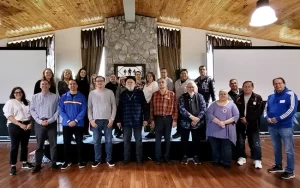Delegates gather for the Find Our Wampum All White conference

By Laurie Leclair
Between 1840 and 1904, First Nations in Southwestern Ontario held Grand Councils, a gathering of Chiefs, interpreters, and Knowledge Keepers mandated to discuss current events affecting their communities. Anishinabek and Haudenosaunee people assembled to read wampum, condole, and strategize on the best ways to deal with colonial impacts while maintaining peaceful and productive relationships among themselves.
The Grand Council of 1858 followed this time-honoured structure, but was also unique in that its subject matter was weighty to the point of existential, and the Crown purposely ignored the meeting itself.
The 1850s were tumultuous times for both First Nations and Canada. Although Confederation was at least a decade away, the Imperial government had begun to extricate itself, administratively and financially, from its colonies of Canada East and Canada West. This included a shedding of its fiduciary duties to Canada’s First Nations. The 1858 Grand Council met to discuss this unsettling trend and determine how to work together to present a unified front. After days of deliberation, the Chiefs crafted a shared response to be sent to Edmund Walker Head, Governor General of British North America, in the form of black and white wampum accompanied by a memorial. Head was asked to review the petition and provide assurances that the anxieties and demands of the Chiefs would be heard. The response from the Crown was to be both literal and symbolic. The Council wanted a written commitment, and a renewed wampum where white beads of protection and support would replace the black ones of unease and concern. We do not know if this memorial ever made it to the Governor General. What’s more, where previous and future Grand Councils were printed and distributed, the 1858 Council was intentionally dismissed by Indian Department officials. That was 167 years ago.
Back to the present time, the week of May 1, several Anishinabek and Haudenosaunee Nations sent delegates to Oshweken to “Find Our Wampum All White”, to revisit this important Grand General Indian Council. The event was a huge success thanks to its organizers York University and Canada Research Chair Dr. Alan Ojiig Corbiere, his associates Dr. Chandra Murdock and Nancy Phillips and the several thoughtful presentations. Many of the people who attended were direct descendants of those who took part in the 1858 Council. Unlike most modern conferences, this gathering did not stray from its original subject, and as the University of Toronto’s Dr. Susan Hill remarked, it provided a chance to talk with each other rather than at each other. Discussions were organized along several themes: The contextualizing of the Grand Council, leadership, Imperial legislation, Indigenous solidarity, and the importance of language and translation. The conference was videotaped by Beausoleil First Nation multi-media artist and curator Lisa Myers and illustrated on paper by Mohawk artist Teyotsihstokwáthe Dakota Brant. Each day, the attendees were nourished by Karen Hill’s catering. Hohahes Leroy Hill, Tehkarihoken Allan McNaughton, and Gaji’nodawehe Steven Maracle provided closing remarks and prayers. The conference ended with a tour of the Woodland Cultural Centre by Heather George, the centre’s Executive Director.
All who attended came away with a greater understanding of the Grand Council structure and, for many, a deeper respect for the Chiefs and leaders who, seven generations ago, demonstrated the importance of communication, solidarity, and peace.
Additional resources:

